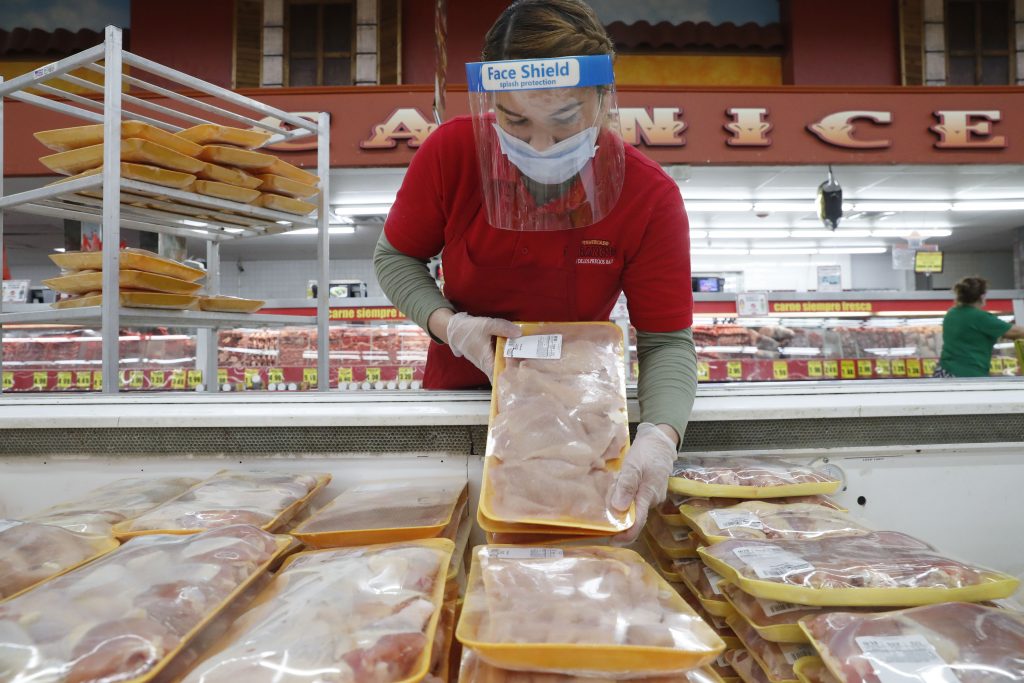The prices of numerous commodities surged in April, with some items like lumber reaching an all-time high. There are multiple reasons for the price increases. The Associated Press has the story:
Prices surged 0.8% in April, affecting everything from consumer goods to housing
NEW YORK (AP) — Rising prices for a variety of commodities are contributing to a jump in prices at the consumer level, with Americans paying more for meat, gasoline, items they keep in their homes and even the homes themselves.
The government said Wednesday that consumer prices surged 0.8% in April from March, while the year-over-year rise was the fastest since 2008.
Prices for corn, grain and soybeans are at their highest since 2012; the price of lumber is at an all-time high.

Many factors are playing into the price hikes. As the economy strengthens, demand for products is outpacing manufacturers’ ability to produce enough supply of the raw materials. Many manufacturers are still understaffed as employment lags the broader economic recovery. Companies are also paying more for shipping as fuel costs rise and ports experience longer delays because of congestion.
CONSUMER GOODS
Everyday consumer items are about to get more expensive as the building blocks of those products become pricier.
Higher costs for polyethylene, wood pulp, refined sugar and milled grains don’t immediately resonate with consumers. But they mean higher price tags at checkout for toilet paper, breakfast cereals, diapers and just about anything in a plastic container.
Consumers have been warned: Cheerios maker General Mills is considering raising prices on its products as grain, sugar and other ingredients become more expensive. Hormel Foods has already increased prices for Skippy peanut butter and its turkey products. Soda giant Coca-Cola has said it expects to raise prices to offset higher costs.
Kimberly-Clark, which makes Kleenex tissues and Scott toilet paper, said price increases will cover about 60% of its product portfolio. Procter & Gamble is raising prices for baby, feminine and adult care products.
AGRICULTURE
Consumers are also paying more at the grocery store for much of the meat they take home and cook, as well as for their favorite takeout burgers and burritos.
The higher prices are the result of a number of factors, including the skyrocketing cost of feed for farm animals, whose diets consist largely of corn and soybeans. The price of corn is up 57% in 2021 and has more than doubled in the past year, while soybean prices are up more than 25% since Jan. 1. Although it can be somewhat gradual, eventually those higher costs get passed down to the consumer.
One factor is tight supplies, in part because China is buying massive amounts of soybeans and corn for feed as it continues to replenish its pork herd that was devastated by the African swine fever in 2018. Scott Gerlt, an economist with the American Soybean Association, says soybean prices will remain elevated at least through the fall.
On an earnings call with investors, chicken producer Tyson Foods said feed ingredients last quarter were $135 million higher than the same quarter last year.
Menu prices are on the rise. The Bureau of Labor Statistics said prices in the “food away from home” category were up 3.8% in the 12 months ended in April. Besides increases in beef, poultry and fish prices, restaurants are spending more on labor, safety training and cleaning due to COVID-19, and passing along some of those costs, according to the National Restaurant Association.
HOUSING
Few areas of the economy have seen inflation intensify like the U.S. housing market. The median price of a previously occupied U.S. home hit a record-high $329,100 in March, a whopping 17.2% increase from a year earlier, according to the National Association of Realtors.
Behind the frenzy is a shortage of available homes for sale, with an inventory that stood at just 1.07 million at the end of March, down 28.2% from a year earlier, according to the NAR. That translates to a 2.1 months’ supply, well short of the six-month supply economists say is needed for a balanced market. In March last year, it stood at 3.3 months.
The shortage of homes and steady surge in prices has begun to put a damper on home sales, which fell in February and March.
Homebuilders are racing to capitalize on the strong demand, but that’s stoking inflation in building materials like lumber, which is up more than fourfold from a year ago, according to FactSet.
The cost of lumber is adding about $36,000 to the price of an average new single-family home, according to the National Association of Home Builders.

While building materials prices always fluctuate, the volatility has been heightened over the past year as the pandemic led to factory closures, a shortage of truckers and other logistical issues that made the supply chain unpredictable.
ENERGY
Energy prices steadied in April but are still up 25% over the past 12 months, according to the BLS.
According to AAA, the average price of a gallon of gasoline topped $3 Wednesday for the first time since October 2014. The price of oil is at $66.40 a barrel, the highest since 2018; more people are driving as the economy recovers from the worst of the pandemic; and some areas of the country are seeing prices rise due to the shutdown of a major pipeline.
A year ago a gallon cost an average of just $1.85 as people hunkered down at home in the early stages of the pandemic.
The vehicles that run on gasoline are getting more expensive as well. Prices for used cars and trucks jumped a record 10% in April. A global shortage of computer chips is curtailing production and leading to higher sticker prices.
__
Reporters Alex Veiga, Matt Ott, Damian Troise, Dee-Ann Durbin and Martin Crutsinger contributed.







